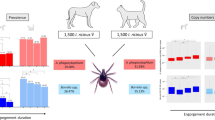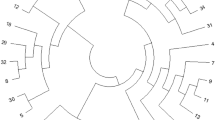Abstract
To determine whether Dermacentor reticulatus ticks are infected by Borrelia spp., Candidatus Neoehrlichia mikurensis, or Anaplasma phagocytophilum, we collected questing adults in the outskirts of Berlin, Germany, examined them for the presence of DNA of these pathogens, and compared the infection rates to those of sympatric Ixodes ricinus ticks. Questing D. reticulatus adults appeared not to harbor the bacterial pathogens that are prevalent in I. ricinus ticks. Based on our sample size, the estimated prevalence of each of these pathogens in D. reticulatus ticks would be well below three tenth of a percent (<0.3 %). For pathogens which so rarely infect D. reticulatus ticks, this tick likely plays no epidemiologic vector role for either their enzootic transmission cycle in nature or their transmission to people.
Similar content being viewed by others
References
Alekseev AN, Dubinina HV, van de Pol I, Schouls LM (2001) Identification of Ehrlichia spp. and Borrelia burgdorferi in Ixodes ticks in the Baltic regions of Russia. J Clin Microbiol 39:2237–2242
Barandika JF, Hurtado A, Garcia-Sanmartin J, Juste RA et al (2008) Prevalence of tick-borne zoonotic bacteria in questing adult ticks from northern Spain. Vector-borne Zoonotic Dis 8:829–835
Gil H, Escudero R, Garcia-Perez AL, Anda P (2005) Identification of a new Borrelia species among small mammals in areas of northern Spain where Lyme disease is endemic. Appl Environ Microbiol 71:1336–1345
Hubalek Z, Halouzka J, Juricova Z (1998) Investigation of haematophagous arthropods for borreliae—summarized data, 1988–1996. Folia Parasitol 45:67–72
Jahfari S, Fonville M, Hengeveld P, Reusken C et al (2012) Prevalence of Neoehrlichia mikurensis in ticks and rodents from North-west Europe. Parasites Vectors 5:74. doi:10.1186/1756-3305-5-74
Kahl O, Janetzki C, Gray JS, Stein J et al (1992) Tick infection rates with Borrelia: Ixodes ricinus versus Haemaphysalis concinna and Dermacentor reticulatus in two locations in eastern Germany. Med Vet Entomol 6:363–366
Kawahara M, Rikihisa Y, Lin Q, Isogai E et al (2006) Novel genetic variants of Anaplasma phagocytophilum, Anaplasma bovis, Anaplasma centrale, and a novel Ehrlichia sp. in wild deer and ticks on two major islands in Japan. Appl Environ Microbiol 72:1102–1109
Kiffner C, Vor T, Hagedorn P, Niedrig M et al (2011) Factors affecting patterns of tick parasitism on forest rodents in tick-borne encephalitis risk areas, Germany. Parasitol Res 108:323–335
Mather TN, Mather ME (1990) Intrinsic competence of three ixodid ticks (Acari) as vectors of the Lyme disease spirochete. J Med Entomol 27:646–650
Matlova L, Halouzka J, Jurikoca Z, Hubalek Z (1996) Comparative experimental infection of Ixodes ricinus and Dermacentor reticulatus (Acari: Ixodidae) with Borrelia burgdorferi sensu lato. Folia Parasitol 43:159–160
Matuschka F-R, Spielman A (1986) The emergence of Lyme disease in a changing environment in North America and Central Europe. Exp Appl Acarol 2:337–353
Matuschka F-R, Fischer P, Heiler M, Richter D et al (1992) Capacity of European animals as reservoir hosts for the Lyme disease spirochete. J Infect Dis 165:479–483
Nijhof AM, Bodaan C, Postigo M, Nieuwenhuijs H et al (2007) Ticks and associated pathogens collected from domestic animals in the Netherlands. Vector-borne Zoonotic Dis 7:585–595
Pal U, Li X, Wang T, Montgomery RR et al (2004a) TROSPA, an Ixodes scapularis receptor for Borrelia burgdorferi. Cell 119:457–468
Pal U, Yang X, Chen M, Bockenstedt LK et al (2004b) OspC facilitates Borrelia burgdorferi invasion of Ixodes scapularis salivary glands. J Clin Invest 113:220–230
Paziewska A, Zwolinska L, Harris PD, Bajer A et al (2010) Utilisation of rodent species by larvae and nymphs of hard ticks (Ixodidae) in two habitats in NE Poland. Exp Appl Acarol 50:79–91
Piesman J, Sinsky RJ (1988) Ability of Ixodes scapularis, Dermacentor variabilis and Amblyomma americanum (Acari: Ixodidae) to acquire, maintain, and transmit Lyme disease spirochetes (Borrelia burgdorferi). J Med Entomol 25:336–339
Richter D, Matuschka F-R (2006) Perpetuation of the Lyme disease spirochete Borrelia lusitaniae by lizards. Appl Environ Microbiol 72:4627–4632
Richter D, Matuschka F-R (2012) “Candidatus Neoehrlichia mikurensis”, Anaplasma phagocytophilum and Lyme disease spirochetes in questing European vector ticks and in feeding ticks removed from people. J Clin Microbiol 50:943–947
Richter D, Spielman A, Komar N, Matuschka F-R (2000) Competence of American robins as reservoir hosts for Lyme disease spirochetes. Emerg Infect Dis 6:133–138
Richter D, Schlee D, Matuschka F-R (2003) Relapsing fever-like spirochetes infecting European vector tick of Lyme disease agent. Emerg Infect Dis 9:697–701
Richter D, Klug B, Spielman A, Matuschka F-R (2004) Adaptation of diverse Lyme disease spirochetes in a natural rodent reservoir host. Infect Immun 72:2442–2444
Richter D, Debski A, Hubalek Z, Matuschka F-R (2012) Absence of Lyme disease spirochetes in larval Ixodes ricinus ticks. Vector-borne Zoonotic Dis 12:21–27
Schwan TG, Piesman J (2002) Vector interactions and molecular adaptations of Lyme disease and relapsing fever spirochetes associated with transmission by ticks. Emerg Infect Dis 8:115–121
Scoles GA, Papero M, Beati L, Fish D (2001) A relapsing fever group spirochete transmitted by Ixodes scapularis ticks. Vector-borne Zoonotic Dis 1:21–34
Shpynov S, Fournier P-E, Rudakov N, Tarasevich et al (2006) Detection of members of the genera Rickettsia, Anaplasma, and Ehrlichia in ticks collected in the Asiatic part of Russia. Ann N Y Acad Sci 1078:378–383
Sixl W, Petrovec M, Marth E, Wüst G et al (2003) Investigation of Anaplasma phagocytophila infections in Ixodes ricinus and Dermacentor reticulatus ticks in Austria. Ann N Y Acad Sci 990:94–97
Tomanovic S, Chochlakis D, Radulovic Z, Milutinovic M et al (2012) Analysis of pathogen co-occurrence in host-seeking adult hard ticks from Serbia. Exp Appl Acarol. doi:10.1007/s10493-012-9597-y
Wielinga PR, Gaasenbeek C, Fonville M, de Boer A et al (2006) Longitudinal analysis of tick densities and Borrelia, Anaplasma, and Ehrlichia infections of Ixodes ricinus ticks in different habitat areas in The Netherlands. Appl Environ Microbiol 72:7594–7601
Zahler W, Gothe R, Rinder H (1995) Genetic evidence against a morphologically suggestive conspecificity of Dermacentor reticulatus and D. marginatus (Acari: Ixodidae). Int J Parasitol 25:1413–1419
Zeidner NS, Burkot TR, Massung R, Nicholson WL et al (2000) Transmission of the agent of human granulocytic ehrlichiosis by Ixodes spinipalpis ticks: evidence of an enzootic cycle of dual infection with Borrelia burgdorferi in Northern Colorado. J Infect Dis 182:616–619
Acknowledgments
We thank Udo Bischoff, Nicole Held, Mandy Marbler-Pötter, and Tanja Meier-Schünemann for expert technical assistance.
Disclosure statement
No competing financial interests exist.
Author information
Authors and Affiliations
Corresponding author
Rights and permissions
About this article
Cite this article
Richter, D., Kohn, C. & Matuschka, FR. Absence of Borrelia spp., Candidatus Neoehrlichia mikurensis, and Anaplasma phagocytophilum in questing adult Dermacentor reticulatus ticks. Parasitol Res 112, 107–111 (2013). https://doi.org/10.1007/s00436-012-3110-8
Received:
Accepted:
Published:
Issue Date:
DOI: https://doi.org/10.1007/s00436-012-3110-8




